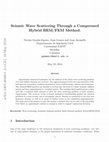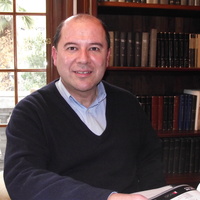Papers by Juan Eduardo Lopez Gomez
Los problemas de toma de decisiones son procesos complejos en los cuales intervienen multiples cr... more Los problemas de toma de decisiones son procesos complejos en los cuales intervienen multiples criterios, por lo cual es necesario utilizar herramientas que permitan discernir entre estos para obtener una solucion que satisfaga en mejor grado la combinacion de alternativas posibles. Una de estas herramientas, es el AHP (Proceso de Analisis Jerarquico). En este articulo se presenta el metodo, y un ejemplo de aplicacion del mismo.
La publicación de los artículos está sujeta a los criterios del Comité editorial y la evaluación ... more La publicación de los artículos está sujeta a los criterios del Comité editorial y la evaluación de los pares científicos. Las opiniones expresadas por los autores son independientes y no comprometen a

Circulation, 2002
The nuclear receptors peroxisome proliferator-activated receptor-alpha (PPARalpha) and retinoid X... more The nuclear receptors peroxisome proliferator-activated receptor-alpha (PPARalpha) and retinoid X receptor alpha (RXRalpha) stimulate the expression of key enzymes of free fatty acid (FFA) oxidation. We tested the hypothesis that the altered metabolic phenotype of the failing heart involves changes in the protein expression of PPARalpha and RXRalpha. Cardiac substrate uptake and oxidation were measured in 8 conscious, chronically instrumented dogs with decompensated pacing-induced heart failure and in 8 normal dogs by infusing 3 isotopically labeled substrates: 3H-oleate, 14C-glucose, and 13C-lactate. Although myocardial O2 consumption was not different between the 2 groups, the rate of oxidation of FFA was lower (2.8+/-0.6 versus 4.7+/-0.3 micromol x min(-1) x 100g(-1)) and of glucose was higher (4.6+/-1.0 versus 1.8+/-0.5 micromol x min(-1) x 100g(-1)) in failing compared with normal hearts (P<0.05). The rates of lactate uptake and lactate output were not significantly different between the 2 groups. In left ventricular tissue from failing hearts, the activity of 2 key enzymes of FFA oxidation was significantly reduced: carnitine palmitoyl transferase-I (0.54+/-0.04 versus 0.66+/-0.04 micromol x min(-1) x g(-1)) and medium chain acyl-coenzyme A dehydrogenase (MCAD; 1.8+/-0.1 versus 2.9+/-0.3 micromol x min(-1) x g(-1)). Consistently, the protein expression of MCAD and of RXRalpha were significantly reduced by 38% in failing hearts, but the expression of PPARalpha was not different. Moreover, there were significant correlations between the expression of RXRalpha and the expression and activity of MCAD. Our results provide the first evidence for a link between the reduced expression of RXRalpha and the switch in metabolic phenotype in severe heart failure.
Revista Colombiana De Cardiologia, Jul 1, 2011
Aneurismas de la arteria pulmonar. Reporte de un caso y revisión de la literatura Aneurysm of the... more Aneurismas de la arteria pulmonar. Reporte de un caso y revisión de la literatura Aneurysm of the pulmonary artery. A case report and literature review
Revista De La Facultad De Medicina, Sep 23, 2011
Revista Ciencias De La Salud, Dec 1, 2011
Revista Colombiana De Cardiologia, Feb 1, 2013

Agu Fall Meeting Abstracts, Dec 1, 2009
The successful prediction of poroelastic properties of fine-grained rocks such as shale continues... more The successful prediction of poroelastic properties of fine-grained rocks such as shale continues to be a formidable challenge for the geophysics community. The highly heterogeneous nature of shale in terms of its compositional and microstructural features translates into a complex anisotropic behavior observed at macroscopic length scales. The recent application of instrumented indentation for the mechanical characterization of shale has revealed the granular response and intrinsic anisotropy of its porous clay phase at nanometer length scales [1-2]. This discovered mechanical behavior at the grain scale has been incorporated into the development of a multi-scale, micromechanics model for shale poroelasticity [3]. The only inputs to the model are two volumetric parameters synthesizing the mineralogy and porosity information of a shale sample. The model is meticulously calibrated and validated, as displayed in Fig. 1, with independent data sets of anisotropic elasticity obtained from nanoindentation experiments and standard laboratory acoustic measurements for shale specimens with and without organic content. The treatment of the elastic anisotropy corresponding to the porous clay fabric, as sensed by nanoindentation, delineates the contribution of the intrinsic anisotropy in shale to its overall anisotropy observed at macroscales. Furthermore, the proposed poroelastic formulation provides access to intrinsic rock parameters such as Biot pore pressure coefficients that are of importance for problems of flow in porous media. In addition, the model becomes a useful tool in geophysics applications for the prediction of shale acoustic properties from material-specific information such as porosity, mineralogy, and density measurements. References: [1] Ulm, F.-J., Abousleiman, Y. (2006) `The nanogranular nature of shale.' Acta Geot. 1(2), 77-88. [2] Bobko, C., Ulm, F.-J. (2008) `The nano-mechanical morphology of shale.' Mech. Mat. 40(4-5), 318-337. [3] Ortega, J. A., Ulm, F.-J., Abousleiman, Y. (2009) `The nanogranular acoustic signature of shale.' Geophysics 74(3), D65-D84. Fig. 1. Comparisons between predicted and experimental elasticity obtained from nanoindentation experiments (left) and acoustic measurements (right) for shale with and without organic content (hollow and solid data points). Nanoindentation elasticity of the porous clay in shale is presented as a function of the clay packing density (one minus the nanoporosity). The x-1, x-3 directions correspond to parallel and normal-to-bedding plane properties, respectively. All nanoindentation data and acoustic measurements for organic-rich shale from [2-3]. Acoustic measurements for organic-free shale were gathered from literature sources compiled in [3].

Approximate numerical techniques, for the solution of the elastic wave scattering problem over se... more Approximate numerical techniques, for the solution of the elastic wave scattering problem over semi-infinite domains are reviewed. The approximations involve the representation of the half-space by a boundary condition described in terms of 2D boundary element discretizations. The classical BEM matrices are initially re-written into the form of a dense dynamic stiffness matrix and later approximated to a banded matrix. The resulting final banded matrix is then used like a standard finite element to solve the wave scattering problem at lower memory requirements. The accuracy of the reviewed methods is benchmarked against the classical problems of a semi-circular and a rectangular canyon. Results are presented in the time and frequency domain, as well as in terms of relative errors in the considered approximations. The main goal of the paper is to give the analyst a method that can be used at the practising level where an approximate solution is enough in order to support engineering decisions.
Del Nacional, Jun 1, 2013
Facultad De Ingenieria Universidad Pedagogica Y Tecnologica De Colombia, 2010
Las características de los movimientos sísmicos se modifican cuando las ondas cambian de medio de... more Las características de los movimientos sísmicos se modifican cuando las ondas cambian de medio de propagación; el contacto entre el suelo y el aire es uno de estos casos, al igual que el contacto entre la corteza y los depósitos de suelo superficiales; a estas modificaciones ...
Journal of Optics, Jul 1, 1986
The visual reaction time has been analyzed as a function of two experimental parameters : size of... more The visual reaction time has been analyzed as a function of two experimental parameters : size of the field and chromaticity of the stimulus. With regard to the first one, field sizes of 0.72, 1.25, 2, 3.5, 5 and 7.5 degrees were studied. The results show that reaction time decreases when the field size increases, also for values above the limits of Ricco's law. On the other hand, the reaction time was measured for chromatic stimuli with dominant wavelengths at 472, 500, 547, 571, 602 and 634 nm. In this case, no correlation between reaction time and chromaticity was found. The fact that these results were in agreement with those obtained for achromatic stimuli at the same luminance was analyzed in terms of color vision models, especially the opponent-colors theory.
Resumen-Se presenta una plataforma robótica inteligente, autónoma y de pequeñas dimensiones para ... more Resumen-Se presenta una plataforma robótica inteligente, autónoma y de pequeñas dimensiones para ser utilizada con fines de investigación y didácticos. Su bajo costo de fabricación, su fácil replicación y su sistema de comunicación, la convierten en un prototipo ideal para generar unidades funcionales que trabajen en forma cooperativa.

Oncotarget, Jan 28, 2016
Acquired proteasome-inhibitor (PI) resistance is a major obstacle in the treatment of multiple my... more Acquired proteasome-inhibitor (PI) resistance is a major obstacle in the treatment of multiple myeloma (MM). We investigated whether the clinical XPO1-inhibitor selinexor, when combined with bortezomib or carfilzomib, could overcome acquired resistance in MM. PI-resistant myeloma cell lines both in vitro and in vivo and refractory myeloma patient biopsies were treated with selinexor/bortezomib or carfilzomib and assayed for apoptosis. Mechanistic studies included NFκB pathway protein expression assays, immunofluorescence microscopy, ImageStream flow-cytometry, and proximity-ligation assays. IκBα knockdown and NFκB activity were measured in selinexor/bortezomib-treated MM cells. We found that selinexor restored sensitivity of PI-resistant MM to bortezomib and carfilzomib. Selinexor/bortezomib treatment inhibited PI-resistant MM tumor growth and increased survival in mice. Myeloma cells from PI-refractory MM patients were sensitized by selinexor to bortezomib and carfilzomib without a...











Uploads
Papers by Juan Eduardo Lopez Gomez
Palabras claves: Percepción, Servicios Ecosistémicos, Humedales, abastecimiento, Cultural, Regulación, soporte y Conexión.